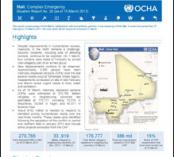
The UN Office for the Coordination of Humanitarian Affairs published a new report on the complex emergency situation in Mali. The report highlights some of the current challenges the health system is still facing in the wake of armed conflict in the North, along with updates from other sectors.
The number of internally displaced persons (IDPs) continues to grow, with 3,500 newly displaced people adding to their ranks over the last several weeks around Talhandak, in the Kidal region. There are now over 270,000 IDPs, with Malian refugees in neighboring countries estimated at over 176,000.
Some of the health-related updates in the report include the following:
- Health facilities in Timbuktu that are not currently supported by humanitarian organizations are facing difficulties in obtaining medications, equipment, qualified personnel, and ambulances.
- IDPs in Talhandak are living in unsanitary conditions, heightening the risk of diseases such as diarrhea, conjunctivitis, and measles. In addition, the area is prone to sandstorms, which can be a vector for acute respiratory infections.
- A rapid assessment of the capacity of health facilities in conflict-affected areas is in progress with support from the World Health Organization.
- Humanitarian assistance missions have been deployed to the regions of Gao, Timbuktu, Mopti, and Segou to strengthen the health system.
- There is a need to strengthen epidemiological surveillance in the North.
Read the full report:
http://reliefweb.int/sites/reliefweb.int/files/resources/Sitrep%2028%20Eng_Final_15%2003%2013.pdf

